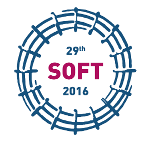Speaker
Christine Klein
(INR)
Description
During the EVEDA phase of the International Fusion Materials Irradiation Facility (IFMIF), the High Flux Test Module (HFTM) was developed as dedicated irradiation device for Small Specimen Test Technique . In the intensive IFMIF neutron radiation field the specimens are contained in temperature controlled irradiation rigs. Since one of the requirements for the HFTM is to provide a uniform temperature field for the irradiated specimens, thermal testing was a priority for the performed validation activities.
In the HFTM “single-rig” (HFTM-SR) experiments a single rig of 1:1 scale was tested, while the neighboring rigs were modeled with heater plates. The heater plates and the specimen region inside the rig were instrumented with thermocouples to monitor heat transfer and specimen temperature spread.
In the High Flux Test Module “double compartment” (HFTM-DC) experiments a fully equipped prototype with three heated rigs was tested in the HELOKA-LP helium loop. Heater cartridges are used to substitute the nuclear heating. These experiments show that the full range of operation temperatures (250 - 550°C) required for the IFMIF HFTM could be well achieved and well controlled with and without “nuclear” heater power. The temperature spread measured inside a capsule is in the range of +/-3K in the lateral direction and +2K / -8K in the vertical direction for the 350°C reference case. This compares to an allowed +/-19K according to the requirements.
No unforeseen thermal hydraulic effects like oscillations, hysteresis etc. could be detected. To cool down from 350 °C to 50 °C it takes roughly 315 seconds, heating up 135 seconds.
Additional the temperature and strain on the container was measured for the tested temperature levels.
Co-author
Christine Klein
(INR, KIT, Eggenstein-Leopoldshafen, Germany)

